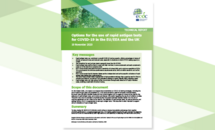Options for the use of rapid antigen tests for COVID-19 in the EU/EEA - first update
On 28 October 2020, a European Commission Recommendation on COVID-19 testing strategies, including the use of rapid antigen detection tests (RADTs) was published. That recommendation called for European Union/European Economic Area (EU/EEA) Member States to agree on criteria to be used for the selection of RADTs, and to share and discuss information regarding the results of validation studies. This document is the first update of the technical report ‘Options for the use of rapid antigen detection tests (RADTs) for COVID-19 in the EU/EEA’ [2]. It is intended to facilitate further discussions between Member States on the settings and purpose for which it is appropriate to use RADTs and summarises key considerations for their implementation. Reaching an agreement on settings and performance criteria will be critical for the success of EU/EEA-wide surveillance purposes and for measures related to cross-border travel.
Executive summary
Key messages
- Rapid antigen detection tests (RADTs) can contribute to overall COVID-19 testing capacity, offering advantages in terms of shorter turnaround times and reduced costs, especially in situations in which Nucleic Acid Amplification Testing (NAAT) capacity is limited.
- RADTs can help reduce further transmission through early detection of highly infectious cases, enabling a rapid start of isolation and contact tracing.
- RADTs are sensitive enough to detect cases with high viral load, early in the course of infection in pre-symptomatic and early symptomatic cases up to five days from symptom onset.
- The predictive value of RADTs is highest in settings where SARS-CoV-2 prevalence is high.
- RADTs are less sensitive than NAATs, especially in asymptomatic patients. • RADTs can also be used in low prevalence settings to rapidly identify infectious cases with high viral load.
- Proper clinical validation studies should be done before introducing new tests in the different settings.
Download







